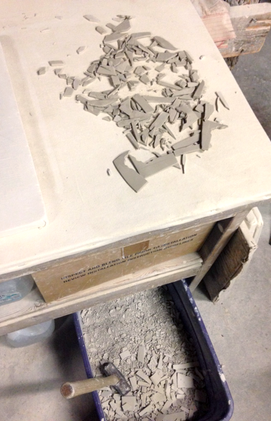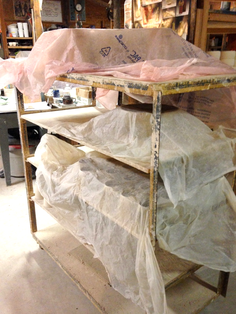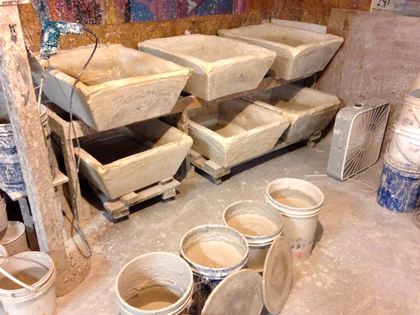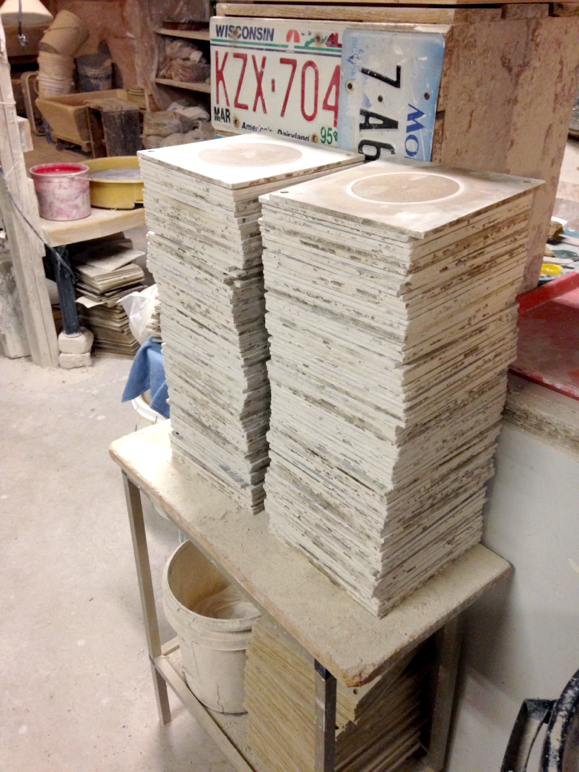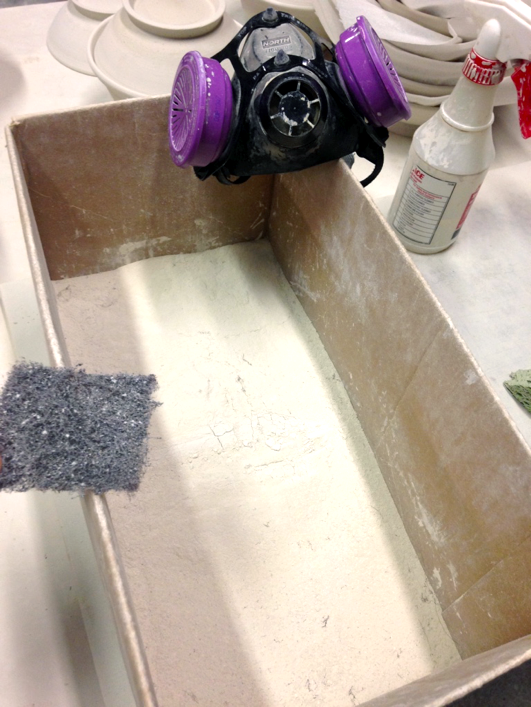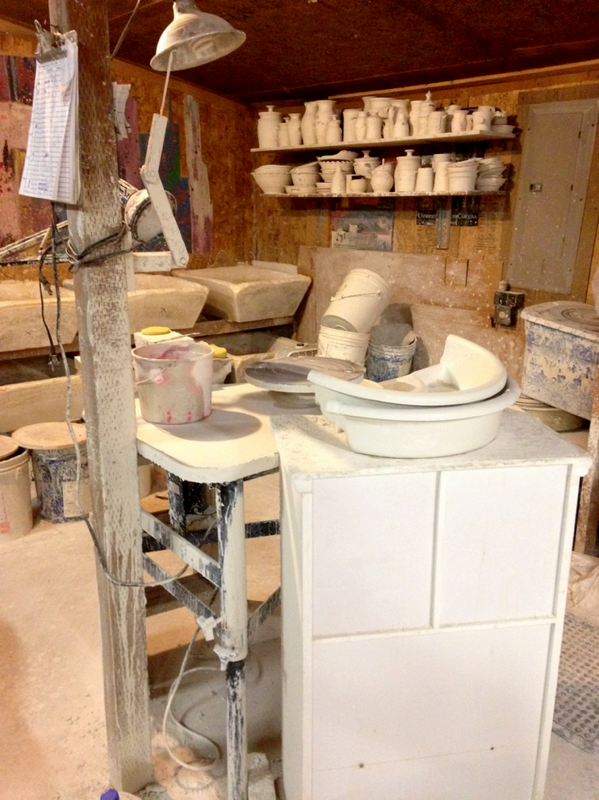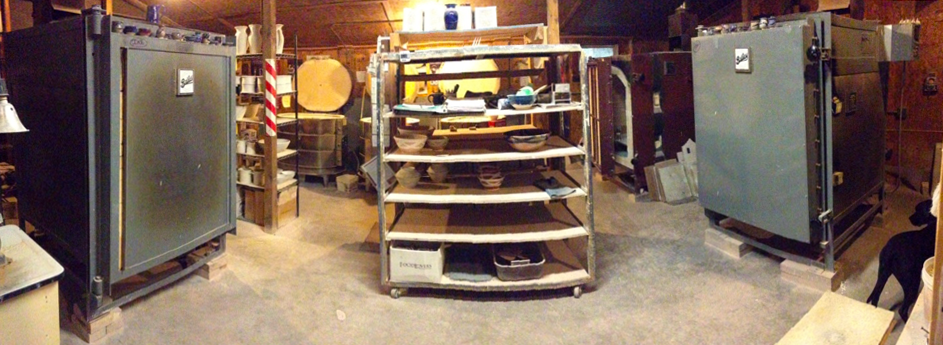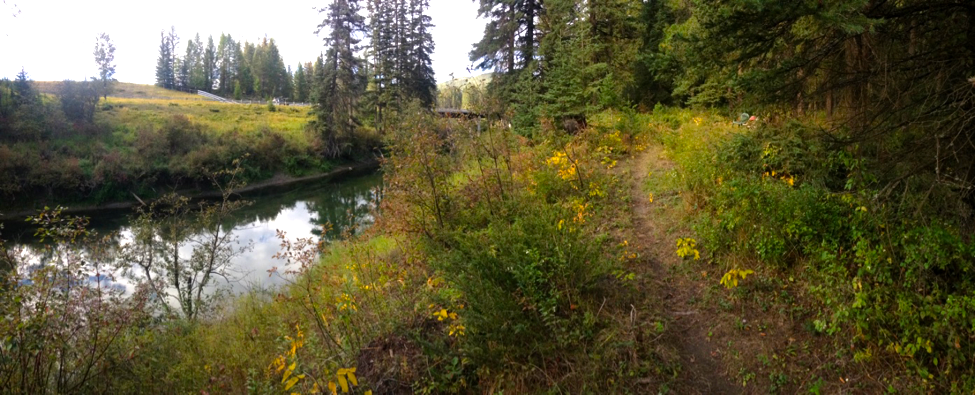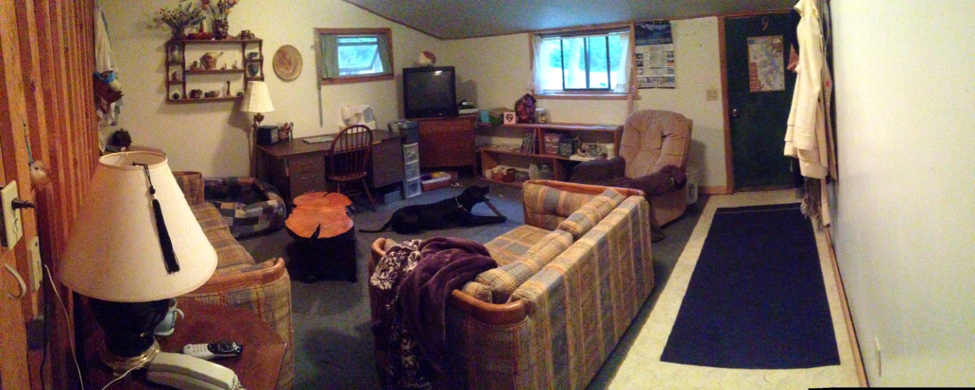|
Article and Images by Stephanie Sanders At the end of August, I arrived in Whitefish, Montana, to start my year as the apprentice at Whitefish Pottery. Tom, the owner, opened the production pottery studio in 1995, and has had an apprentice for the last 20 years. The company makes a variety of household items and ships all over the U.S., to both individual and wholesale customers. Their mini pots are sold all over the country, and I found out the Telfair Museum in Savannah has a wholesale account with them!
The studio uses production bats, so each item is left on them after being thrown until it pops off. Pretty much all the trimming is done at the time the item is thrown, and I sand any sharp edges once the bat releases it and it is bone dry. Because sanding causes so much dust, I spend a lot of time wearing my dust mask. John, the production potter, gets a list of different items and their quantities that he needs to throw every day. The shelf on the back wall has one of everything the studio produces and has the dimensions and weight of the clay marked on each one. He uses a paintbrush near his wheel to make sure everything is the right height. The day after a rack of 21 mugs or 18 chili bowls are thrown, I attach handles to them. I start by rolling out enough little cones of clay for each mug or bowl I plan on doing. Then one at a time, I slip and score the large end to the top of the mug or bowl, smooth it out, pull the handle until it is the right length and thickness, and attach it to the bottom. I’ve recently worked my way up to doing entire racks of both of them instead of just a few every day. The hardest part is making them all look the same, but I’m sure I’ll be able to handle it soon enough. Many of the items get patches, so I learned how to attach them. Mugs are the most popular, but the patches also go on things like crocks, steins, sugar bowls, and French butter keepers. The studio manager, Beth, rolls out a slab and uses metal plates to stamp out the image and/or phrase. She cuts each one into the correct shape, and from there I slip and score them onto the mugs. You can see some of the patched mugs with the Montana area code on them in the slideshow below. All the sanded greenware is taken to these shelves in the kiln room where there are three gas and three electric kilns. The wood fire kiln is behind the studio, and it only gets fired once a year since it takes five days and needs constant monitoring. I’m looking forward to learning more about it in May! There is a glaze area where there are 12 different glazes. Eric, who does the glazing, makes all of them except one that gets ordered. I haven’t done too much glazing here yet, but I’m looking forward to experimenting with different colors and recipes. The two large gas kilns both get fired about once a week, each to cone 10. Each firing takes about 12 hours, and a timer gets set to go off at different times throughout the firing so the kilns can be adjusted as necessary. Tom is usually the one who starts and turns them off, but I have been learning how to do it. He is getting knee surgery in a couple weeks and won’t be able to make it down to the studio, so I will have to do it while he recovers. The pilot light gets lit the night before to warm up the kiln, and the actual firing starts at 6 A.M. the next morning. After turning the burners on at that time, I have to go back again at 7 and 7:45 A.M. to turn them up and record the temperatures. Eric takes over at 8:30 A.M. and monitors the firing all day until the kiln is ready to be shut off around 6 P.M. It’s a bit rough getting up so early, but I’m glad I’m learning how to do it. My dog Monty, who was able to come with me, loves when the gas kilns get fired, and it didn’t take him long to figure out the best spots in the studio. The only downside of the studio is that there is no running water. Once or twice a week, I have to roll a wheelbarrow full of empty milk jugs to the house, fill them up with the hose, and roll them back. It’s great for conserving water, but I’m not looking forward to doing it in the snow. Everyone who works at the studio is a potter, and they each get an area to work on their own projects. As the apprentice, I get a bigger area with my own work table, wheel, and shelves. I've been able to make a variety of things so far. I got my first batch of mugs out of the glaze firing this week, so I can glaze the rest now that I know how they’ll turn out. I get to sell my work in their downtown store, so I’m hoping to have more finished pieces soon! I live on the property in an apartment with a living room and bedroom. Again, there’s no running water in the apartment, but I have my own bathroom in Tom’s house, which is fortunately only five steps away. I have a mini fridge, microwave, and toaster oven, and I share the kitchen in the house. The property is about five acres and has a nice trail in the woods by a river. I love being able to live in such a beautiful place. Monty loves his new home too. After living in downtown Savannah, he’s not used to having so much space to run around. He comes to work with me every day, so we’re always together. He and Tom’s dog, Komo, got off to a rough start, but it seems like they’re finally warming up to each other.
It didn’t take Monty long to learn how to operate the screen door in front, and he easily lets himself in and out. He’s gone on a couple adventures, but he’s been good about coming back so far. One day he ended up at the neighbors’ house, and they kept him in their horse stall until I picked him up. He still has his Savannah tag, so I don’t think they realized he lives here. The job is a lot of work, but I really enjoy it so far. There’s always something to do, and I’ve learned a lot already. I truly miss Savannah and everyone there, but I think this was definitely the next step I needed to take in my career. I’m looking forward to the rest of year! Here is the website for Whitefish Pottery: http://whitefishpottery.com/ Read more about Stephanie's work on her website, http://www.sanderamics.com/ or at her SAVCC artist page.
0 Comments
Leave a Reply. |
